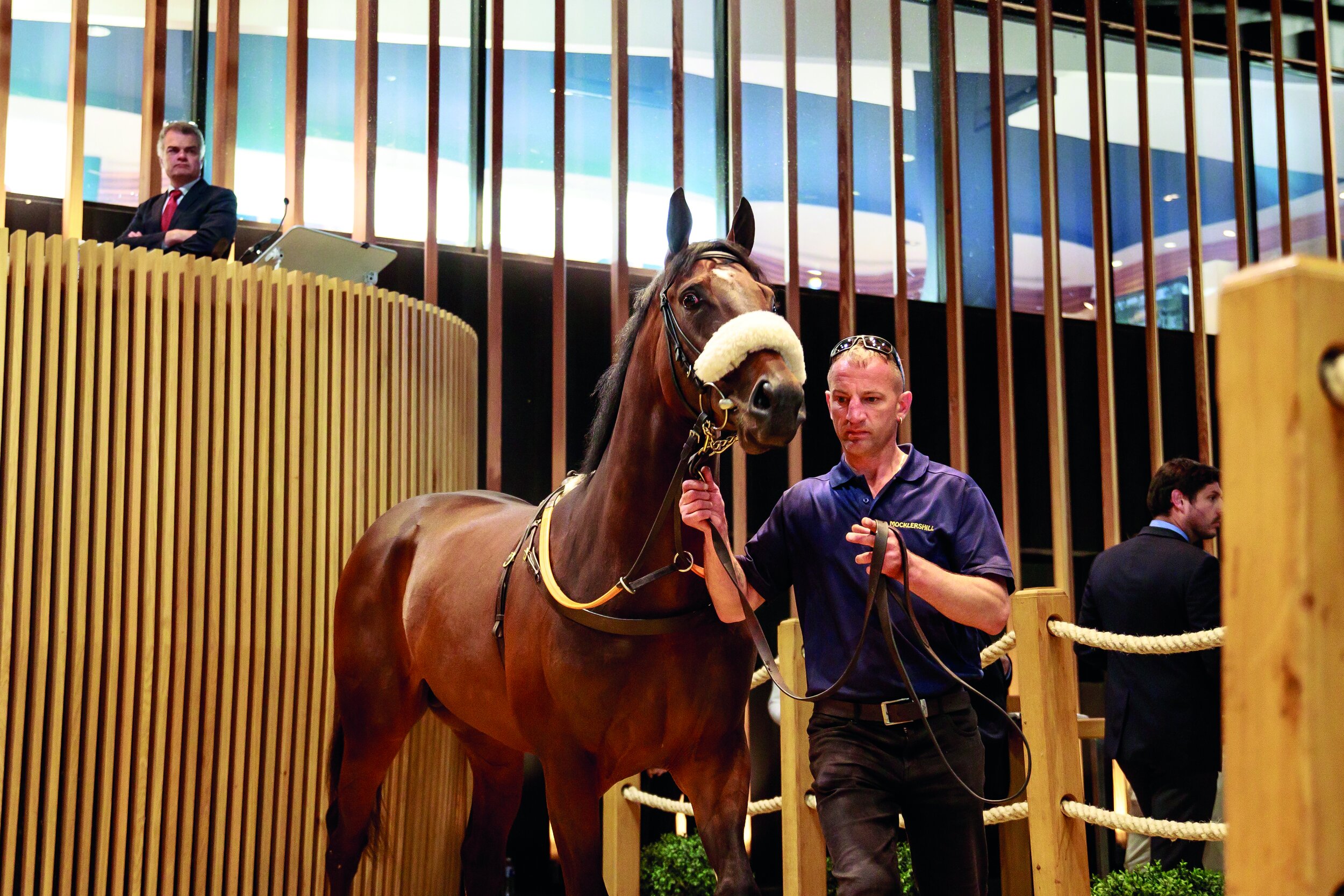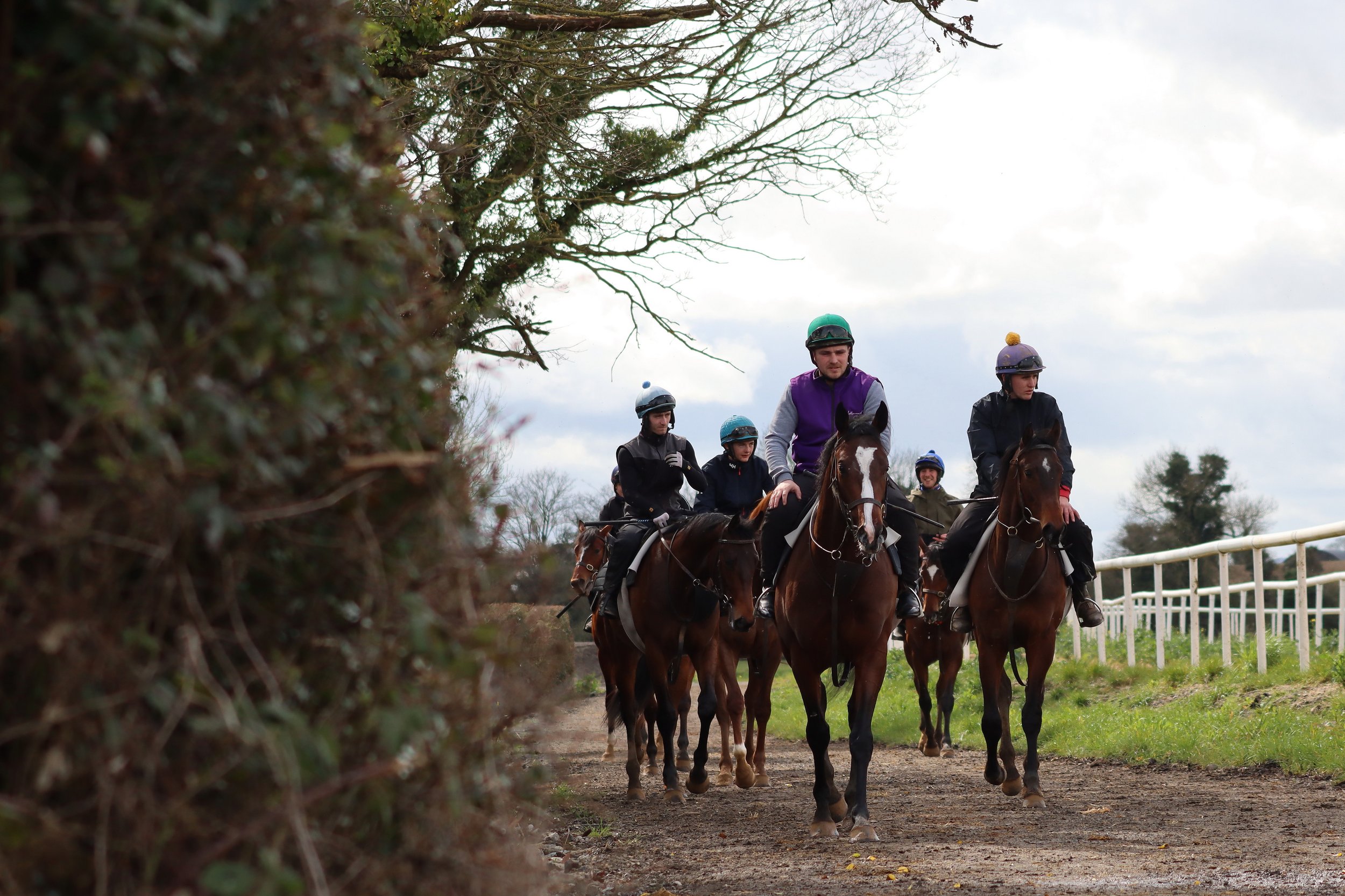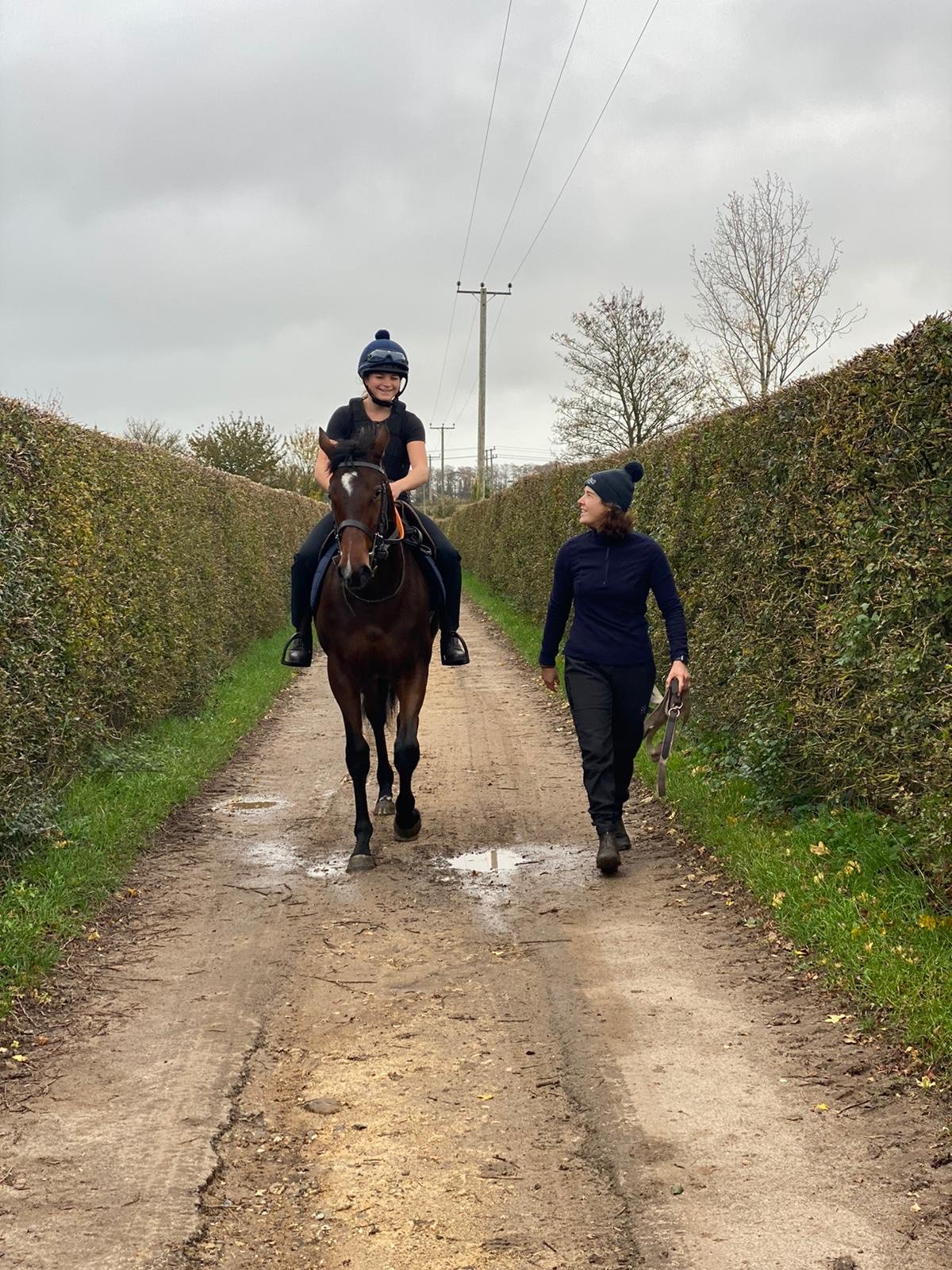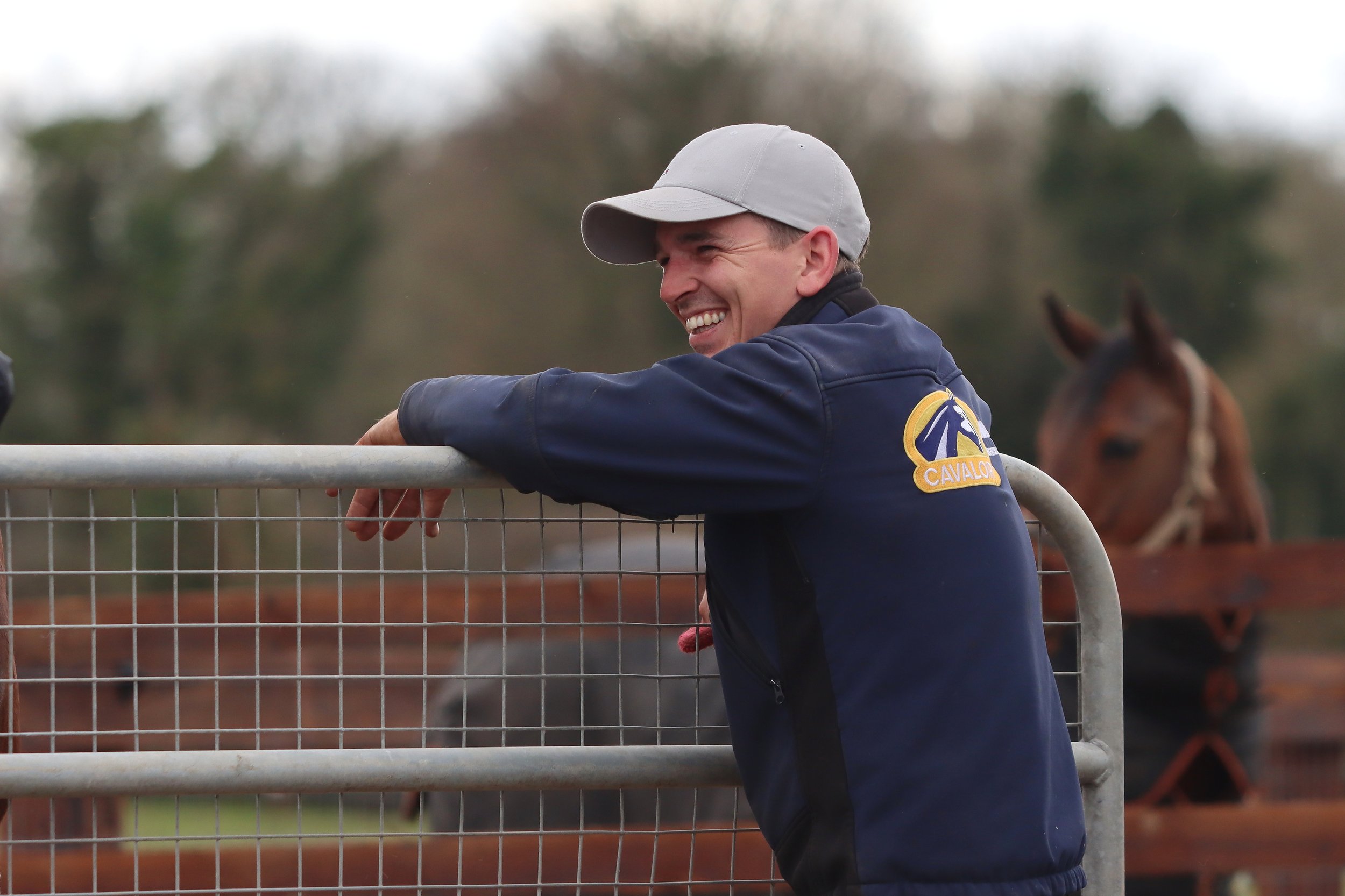Prep school - the role of the pre-trainer in the flat racing world
Article by Daragh Ó Conchúir
WC Equine’s Ellie Whitaker & Tegan Clark
Having had a little poke around the inner workings of pre-training in jumps racing for the last edition, it is now time to do the same in the Flat world.
In both National Hunt and Flat, owners and trainers send horses to be broken and prepped specifically to race, enabling trainers to get on with the job of attending to those in their yard that are ready to run.
Then there is the trading side. In jumps racing, that revolves around the point-to-point scene, where proving a level of ability in competition increases value. In the Flat division, the breeze-up sales are not competitive, but they illustrate athleticism, temperament, physical prowess and of course, raw speed.
While very successful, pre-trainers aren’t universally popular. As mentioned in the pre-training jumpers article, retired trainer and former CEO of the Irish Racehorse Trainers’ Association Michael Grassick argued that they were making an already difficult staffing situation for trainers even worse.
Last February, recently retired trainer Chris Wall asserted in a Racing Post feature that the proliferation of pre-trainers was accelerating the growth of the so-called super trainer, enabling them to stockpile horses.
But then, in the same article, Ben de Haan described the demand for pre-training as a very welcome opportunity to improve revenue streams.
Obviously, Flat racing is a more global field than jumps, so we had to be a little less parochial in sourcing our contributors; we touched base with successful operators in England, France and Ireland, namely Nicolas Martineau, Ellie Whitaker, Tegan Clark, Willie Browne and Ian McCarthy.
Willie Browne
Browne is featured elsewhere in this publication for his training prowess, but it is his nonpareil acumen in sourcing future champions as young stock and then producing them through the breeze-ups that he can hang his hat on. It’s also a lot better way to pay the ever-escalating bills.
Now approaching his 77th birthday, he has more than 40 years’ experience in this sector, having consigned a draft at the very first breeze-up sale in 1978. And though he has moved from the original Mocklershill location outside Fethard, Co Tipperary, to build Grangebarry Stables just over the road, he has retained the home label as a brand for excellence.
It was Browne who sold the first breeze-up graduate to win a Classic, when Speciosa galloped to victory in the 1000 Guineas in 2006, little over a year after breezing at Doncaster. Walk In The Park and Trip To Paris are others to go through his hands while Mill Reef Stakes victor Sakheer has the 2000 Guineas in his sights in the coming months.
Zoffany colt Sakheer
He has broken the million-pound barrier twice at the sales and was one of the first to explore the American market for value when buying horses to breeze—Sakheer, a most recent example having been acquired as a yearling at Keeneland for $65,000 in September 2021 and then making €550,000 at Arqana, eight months later. A year and two days after he was picked up in his native land, the Zoffany colt was a three-and-a-half-length winner of the Mill Reef.
Browne also has a lengthy list of clients who send horses his way to break and pre-train, including Coolmore, the Niarchos family and Canadian owner Chuck Fipke. He trained Spirit Gal to bag a listed prize for Fipke last season before she was moved on to continue her career with André Fabre.
“When we are at it as long as we are, and we know our gallops, it’s fairly smooth,” says Browne. “Basically, we train horses here to run fast for two and a half furlongs, maybe three furlongs. That is what they are gauging you on.
“If you are training and you get to your three-furlong pole, and when you go to the next furlong, then you know if you have a racehorse or not. Because if horses are going very fast for two and a half or three, they’ll invariably slow down. But Spirit Gal wouldn’t slow down. That’s our yardstick, if we think we have something good.
“In pre-training, you wouldn’t have to put in the miles that you’d put in with the horses that are breezing—less time on their backs, you know? I have two horses going away tomorrow—one to John Gosden and one to Ralph Beckett—and we would never have put a gun to their head. I wouldn’t want anybody to think we gun the daylights out of these breeze-up horses, but you have a better idea.
“The horses for trainers, the half-speed is as far as they’d have ever gone, unless they gave them to you until July or August. They’d usually go between March and May. The pre-training is great … it keeps the whole business ticking along.”
Le Mans is noted for horsepower of a different kind, but Nicolas Martineau and his wife Pauline Bottin have a premises just 20 minutes from the venue for the world-famous 24-hour rally that in five years, has established a reputation for producing speed on four legs, rather than wheels.
Among their clients are the Devin family, Louisa Carberry, Tim Donworth and Alessandro Botti. Last year’s Gp. 1 Prix Royal-Oak winner Iresine was one of the earliest graduates from the Martineau school while of the younger crop, Good Guess was placed in a listed race as a two-year-old last term. Starlet du Mesnil and Enfant Roi are some of the graded jumpers he has prepped, while British and Irish followers will know the high-class Fil Dor well.
“At the stable I work with a lot of trainers,” Martineau . And with each horse, we work like the trainer works. We don’t work a horse for Francois Nicolle like we do for Gabriel Leenders. We do specific work, horse by horse.
“The big problem in France is staff, personnel for racing stables. So the trainer, when they call me, they want me to prep the horse to be ready to go racing in four or five weeks, six weeks maximum, just after they leave me. You are doing all the pre-training but up to the stage too where they are ready to go racing.”
That is clearly a dissimilar approach to what is required by most British and Irish trainers, but one aspect of it that is very similar is the staffing shortage, which Browne attributes to his numbers being down to around 50 this year.
Back in France, Martineau even has different feed for the breeze-up two-year-olds and those in pre-training because they are not being trained for the same jobs; and his time learning about both sides of the equation has informed his methods.
“I have my experience from Ireland. I worked for Mick Murphy at Longways Stables. For me, he is the best for the breeze-ups, and I learned so much. He’s exceptional, and I took a lot from working with him.
“I worked for a long time for Jean-Claude Rouget. I worked for a year as well with my wife Pauline for Willie Mullins, and she worked as well for Joseph O’Brien. That was very good experience for pre-training.”
Indeed, the woodchip gallop is a mid-way point between what Mullins and O’Brien have at Closutton and Carriganóg respectively, so that they can cater for all types of horses.
McCarthy is a former NH jockey who had already built his breaking, pre-training and breeze-up operation, Grangecoor Farm on a greenfield site in Kildangan, Co Kildare by the time he had retired in July 2021.
The 34-year-old, who expects to have between six and eight juveniles bound for the Craven, Guineas and Goresbridge Breeze-Ups (while also breaking and pre training Flat and NH youngsters for the racetrack directly and producing jumps horses through the point-to-point sector), places a heavy emphasis on detail and that means not taking any shortcuts, even with spiralling costs.
“I spent ten years with Dessie Hughes and he was a horseman in himself,” McCarthy explains. “I was always interested in the breaking side of it with the stores during the summer, so it was always something that was in my mind from then that I might do.
“I went from there to Ted Walsh, where I learned an awful lot that stood to me when I started breaking and pre-training.
“I put it out there that I was doing it and was lucky enough to have ridden for some good owners that supported me when I was starting out and good trainers when I was freelancing that supported me as well.
“We have about 50–55 horses here, which is a number that works very well. I am so lucky, given how difficult it is for everyone to get staff in that I have five excellent full-time people here. Niall Kelly is head man, and Alan Davison, Johnny Wixted, Sean Donovan, Christine Worrell and Orla McKenna are with me as well. They are vital. We also have eight part-time workers.”
In his experience, there are varying techniques for getting to the same end game of a horse being prepared to give its best on race day. What is sure is that you cannot bring the same approach to every model.
“You try and get to know the horse the best you can. You’ve different types of horses—horses coming from the sale and homebred horses coming from the farm. The sales horses will have a sales prep done and will have that under their belt. Horses coming in off the farm just won’t be as advanced, so they’ll take a little more TLC.
“Here, the yearlings are started off in the lunge ring and are driven for a couple of weeks. They then go on the furlong sand-and-fibre gallop. Then, just before Christmas, they’re put on the three-furlong round sand-and-fibre gallop.
“From day one they’re driven through the stalls so that they adapt to it really well.
“I do like to get the two-year-olds away at the end of January, start of February. We use The Curragh on a regular basis for a day away. It’s an important part of it.”
Two of the best illustrations of Grangecoor’s work arrived in 2021, starting when he had Hierarchy for the Tattersalls’ Guineas Sale. The son of Mehmas breezed the second-fastest time and was sold to David Redvers for 105,000 guineas, going on in the following months to win twice and be placed twice at group level, before only being beaten a length and a quarter in the Breeders’ Cup Juvenile Turf Sprint.
Hierarchy – Tattersalls Guineas Breeze Up Sale 2021
The same year, he was sent a Profitable filly that had been purchased privately by Liam Donovan on behalf of the Dunphy family. The pocket rocket turned out to be Quick Suzy, who would shed her maiden status at Curragh Racecourse before blitzing the opposition in the Gp. 2 Queen Mary Stakes at Royal Ascot.
“You get a great thrill and satisfaction from something like that. I’d say it’s more satisfying than when riding a winner because you’re putting an awful lot more time into them, and you actually get attached to them and love to see them do well.”
Ellie Whitaker (26) and Tegan Clark (33)
Ellie Whitaker (26) and Tegan Clark (33) set up WC Equine in September 2020, as the world was in Covid lockdown. It wasn’t ideal, but with Robert Cowell looking to let out a yard at Bottisham Heath Stud in Six Mile Bottom, just outside Newmarket, they took the plunge.
What has been so vital for them, given the difficulties in finding enough good staff, is that they are both hands-on, able to muck out and ride, with 35 boxes full. Between the two of them, they broke 64 horses in a five-month period.
Having Newmarket facilities was a considerable help in getting established quickly but so was the initial support of trainers Kevin Philippart de Foy and Roger Varian. They sent yearlings to break and pre-train, while Brendan Morrin of Pier House Stud utilised their services to prep some more for the breeze-ups.
Tegan Clark
Whitaker was working for Cowell at the time, having started out with Mark Dwyer, the former Gold Cup-winning pilot who is a wizard of the breeze-up realm and indeed, has enjoyed extensive success in tandem with Browne. She also worked for Charlie Appleby and among the horses she broke in was triple Gp. 1 winner and champion two-year-old, Pinatubo.
Meanwhile, Clark had worked for Varian. That early support allowed them to showcase their talents, with James Fanshaw and Sean Woods among new clients this year.
“Last year was the first year we managed to get a good client specifically for the breeze-ups,” Clark explains further. “We also bought a few ourselves and have shares here and there, but this is the first year people have rung us and put horses with us to specifically breeze; and we want to try and build on that this year to take those relationships and partnerships into the future.”
This was on the back of two notable successes at the Guineas Sale. In 2021, Royal Aclaim won a maiden within a month of being consigned by WC Equine for Pier House. She won twice more at three and though losing her unbeaten status in the Gp.1 Nunthorpe when favourite, she ran creditably in sixth and was placed subsequently at group level.
Having Newmarket facilities was a considerable help in getting WC Equine established quickly.
Twelve months later, Village Voice was sold. Not the same type of model, she holds an entry in the Irish Oaks for Jessica Harrington, after having just two runs in October, winning her maiden and finishing third in a Gp.3.
“You’ve got to be honest and educate the horses as well as you can so that they do have a lasting career within the sport. It’s brilliant to have a mature two-year-old that’s breezed, but then that’s going to go on and probably have a lovely three-year-old, if not four-year-old career with Jessie Harrington. She already has her black type. So as long as you keep producing that sort of quality, people take notice.”
Initially, all the yearlings go through the same routine, though never together.
“The breezers go through the same process as the pre-trainers from breaking until Christmas time. We give them all a break then; but when the breezers come back in, they have to start knuckling down. You can’t expect a pre-trainer to lay up with them because we are putting the breezers under pressure a lot earlier.”
“There’s a fine line,” notes Whitaker in relation to horses being pre-trained for owners and trainers. “We’re not here to physically break horses or to see how good they are. Our job is to get them through the breaking process and get them up to a path in the training process where they can go up to town (Newmarket) and go up Warren Hill with ease—get them to a business level.
“Every trainer is different, their standards are different and it’s about meeting their standards and what they require. At the end of the day, it’s a product we’re selling and that product needs to appeal to each individual. We’re equipping these young horses with the right tools; and if they can go into a training facility with the right sort of attitude—be calm and confident, we know we’ve done our job well then.”
In terms of the breeze-ups, with Browne owning most of those horses himself or in partnership with others, sourcing is key. He dabbles in buying foals with long-time ally Dwyer, but the majority are yearlings.
“The trouble with nice horses is they might not be racehorses. When we are looking now, we are looking for a completely different type of animal than that we used to look at 10 to 15 years ago. You’d buy a nice-looking horse, with a nice pedigree and if he breezes up with a nice action but maybe not going that quick, he’s compared against nothing else; and if they like what they see and if they like the movement and the horse’s page, and he’s good looking, you are going to get him well done.
McCarthy learned from the likes of Dessie Hughes and Ted Walsh that stood him in good stead when he started breaking and pre-training
“Now I’ve a horse out there that I gave three hundred grand for, and he’s going to the sale in France. He’s by a sexy American sire Into Mischief, he’s training very well and we hope we’ve struck gold; but If he doesn’t breeze well, no matter how well he’s bred or how nice he is, you’ll get badly hurt.”
Nice horses are pricier than ever before, so Browne will prioritise the page and walk if he must. McCarthy suggests that at his price range, “you have to be lenient towards the page... I’ll focus on the individual.”
And while the breezers are pressed far more than pre-trainers because of the more immediate job they must do, McCarthy argues that you can’t make them faster than they are.
“You’re just trying to get the nice individual with the suitable and affordable pedigree, and then to keep them sound and watch their minds, as they are only two-year-olds and still developing.”
“We would be riding horses ten days after they came in,” Browne details his system for the breezers. “When you’ve big numbers, it is a matter of getting them done, but I wouldn’t say a word to somebody who is five or six weeks breaking a horse. There is nothing wrong with that; it’s good practice.”
Everyone agrees that good communication is crucial, be that in terms of honesty about the calibre of animal you are selling or being able to pass on as much information as possible to whoever is taking on a horse you have pre-trained.
In France, once again, it goes a little further.
“Sometimes clients will say, ‘I would like to go to this trainer with this horse’; but I might say, ‘I’m not sure, for this horse, it might be better to go to this one,’” Martineau reveals. “When you know the horses, you know what trainers might be suitable, and that gives the client confidence.”
Apart from staffing, increased costs is a huge challenge. Browne changes the wood chip on his gallop twice a year, and says it is 50 percent more expensive than before.
Martineau points out that the expenses are like those of a licenced trainer but that pre-trainers in France charge around €30–32 a day, while full trainers will get in the region of €70. Still though, he likes having a little more time and a little less pressure. The trade-off is worth it, particularly as the business has been built up now and is making money.
McCarthy offers a pragmatic tone abouts the price of everything rising. It eats into the bottom line, but it cannot lead to a reduction in the calibre of his service, given how appreciative he is of the loyalty shown to him by his various clients.
“The big thing for me is attention to detail,” McCarthy emphasises. “That is of the utmost importance through the entire process, and that starts with feed and every step of the way after that.
“Everything is more expensive now, but I look at it that you put in the best of what you need. You can’t cut corners. What you’re doing is educating young horses, and that’s how we see ourselves—as educators of young horses before they join the big boys and go into the next stage of their lives. You need to do everything right, no matter what it costs.”
It is interesting, given Wall’s criticism in particular, that McCarthy will have horses all year around, but that is imperative according to the Galway native, as you have to tailor your approach to the systems horses will be entering.
“For the different trainers we work for, we know their regimes and try to have the horse prepared for them to fit into their regime when they think they’re up to it. The ideal is for them to go in February, but it doesn’t always work like that as all horses are different.
“All the big trainers are going up in numbers. Early into the year and early into the Flat season, we’d be dealing with a lot of the backward two-year-olds and trying to organise them for trainers, giving an opinion of what’s early and of what wants a little more time. And the ones that want a little more time, we’ll be holding onto them and letting them progress and grow into themselves.
“Plenty of trainers would have a couple with me that are not going to be early two-year-olds. They’ll be built up and they’ll be rode in bungees to try [to] strengthen them up and put a top line on them. It’s basically strength and conditioning we’re doing with them.”
Browne states that even the horses he has pre-trained that are being sent to England will most likely go to another pre-trainer, due partly to offset fears of any bug being transmitted, but also because they are full.
“Chris Wall wouldn’t be mad about what we do, but I would go along with what he said about it helping the big trainers stock up,” Browne remarks. “You are taking away half a year’s livelihood from him by doing what you are doing.”
“Unfortunately, trainers don’t have the staff,” observes Clark. “We’ve got the room, we’ve got the availability, we’ve got the staff.
“We’ve got trainers in the hustle and bustle of Newmarket who send horses to us 10 minutes down the road. They might only use us for 10 or 14 days in the summer on grass, keep them ticking over; and then they go back in and are running straight off of that and are happy with the results. The horses are running well.”
And that’s the point. Be it breaking, pre-training, a little R&R, prepping for breeze-ups—the results speak for themselves.
“It’s about being calm and straight,” concludes Martineau. “The voice is always calm. I want my horses very calm and straight on the gallop. If that happens, they can go to the races anywhere and whenever you want.
“They are ready.”













